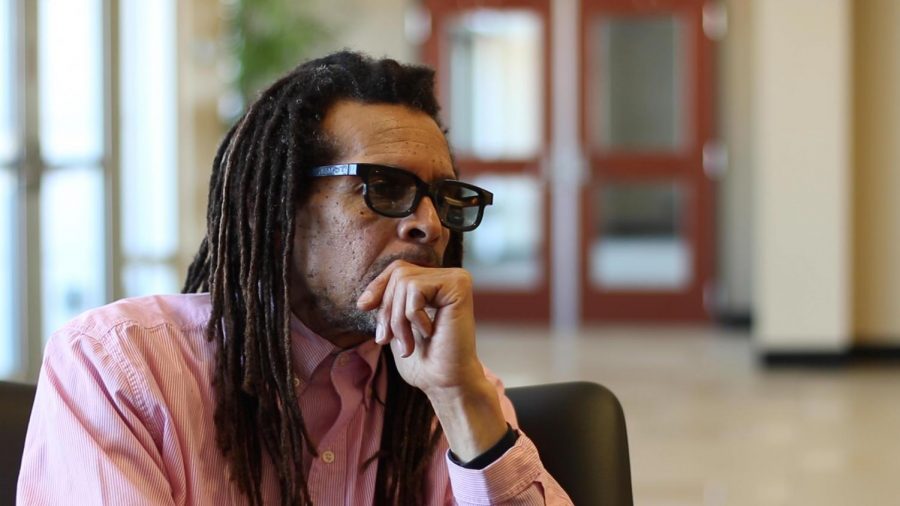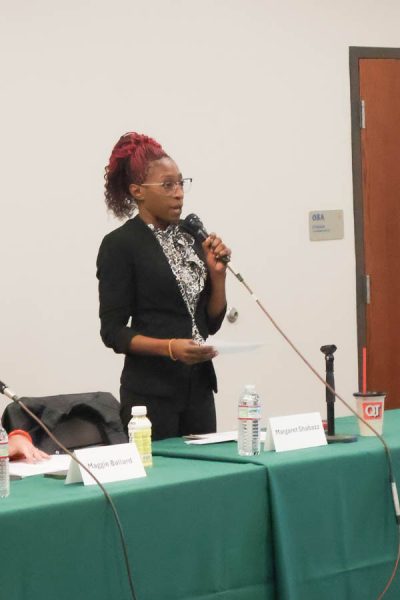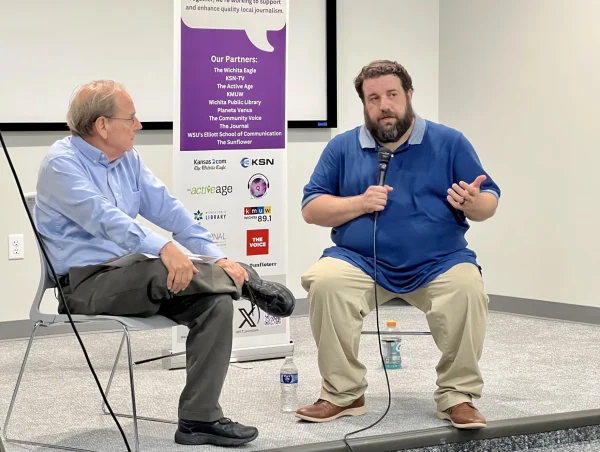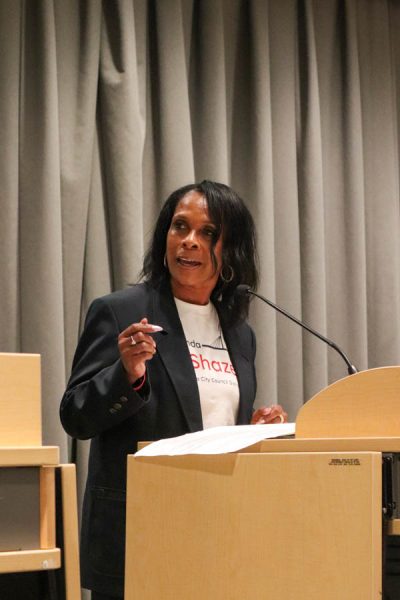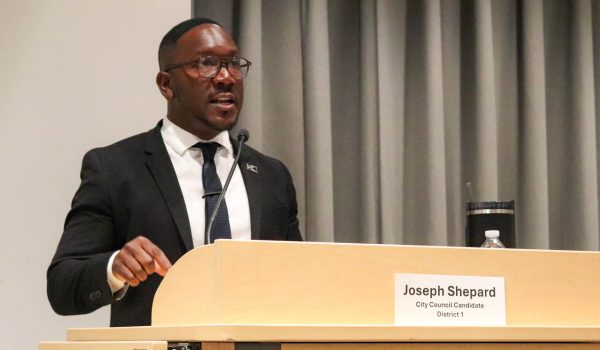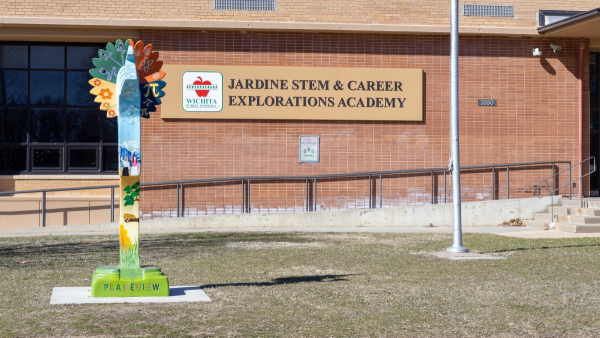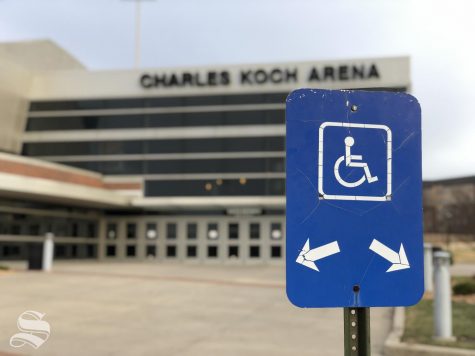Did WSU’s ‘Enough is Enough’ campaign do enough for Fairmount?
Wichita State hired Darryl Carrington to head community relations between the university and Fairmount residents for the Enough is Enough campaign.
The Kansas Health Foundation gave Wichita State a quarter of a million dollars to use on community engagement with Fairmount after the brutal rape and murder of Letitia Davis. For three years, WSU went full steam ahead on community development and research, but that grant money ran out in 2018.
Since then, WSU’s involvement with Fairmount seems to have tapered off. Since the summer of 2018, WSU has engaged in Fairmount primarily through a healthy initiatives Win The Day grant, also funded by the Kansas Health Foundation. That money runs out in the fall, and the future of WSU’s Fairmount community involvement remains uncertain.
Wichita State launched the “Enough is Enough” campaign in the wake of the November 2014 murder. Darryl Carrington, an adult learner at WSU and president of the Fairmount Neighborhood Association at the time, was hired to head community relations between the university and Fairmount.
Carrington worked for WSU on the resulting programs and outreach activities for 30 months. Fast-forward to 2019 and it appears WSU’s involvement in Fairmount is waning.
Originally from Compton, California, Carrington and his wife, Cassandra, live in the Fairmount neighborhood. When the two were traveling from California to South Carolina in 2005, Cassandra wanted to stop in Wichita to see her mother. During that visit, Cassandra learned that she had a tumor and needed emergency surgery. They stayed in Wichita for treatment.
Darryl Carrington started working for the physical plant on WSU’s campus. He also enrolled at WSU to finish his bachelor’s degree and got involved on campus.
“I became a [student] senator. And I started advocating in Topeka for increased wages and stuff like that on behalf of the physical plant employees,” Carrington said.
He also encouraged WSU to get involved with Fairmount, well before the Enough is Enough campaign kicked off.
“I was engaged. I was trying to get Wichita State to bring some of their resources across 17th Street, south of 17th Street, like the performing arts, their stage, and their equipment,” Carrington said.
Then the Davis rape and murder happened. Suddenly, WSU became interested in engaging with Fairmount in a new way with vigor.
Late President John Bardo addressed this in a December 4, 2014 message to the community.
“Enough is enough. We all felt the horror when Letitia Davis was brutally assaulted in Fairmount Park and later died from her injuries. In the months before that, there were reports of assaults, car break-ins and other crimes in the area south of campus,” Bardo wrote.
“Yes, we live in the largest city in the state, and yes, crime will happen. But, enough is enough. We’ve got to fix this and it’s time.
“We can, and will, do more.”
Bardo also wrote that he had asked then Director of the Office of Community Engagement Ted Ayres to head the Enough is Enough task force, “to focus on creating safe, economically vibrant neighborhoods near campus.”
The Kansas Health Foundation Grant
Meanwhile, Carrington was also working on behalf of the Fairmount community.
Carrington said he played a role in securing the $250,000 Kansas Health Foundation (KHF) grant under the direction of Misty Bruckner, director of WSU’s Public Policy and Management Center (PPMC).
Carrington was a lecturer at WSU at the time, leading a class called Art and Community Engagement.
“Misty just asked me if I could put together a video to go along with the grant, which I did with the help of my students in the class,” Carrington said.
He went around with a camera and interviewed members of the community. One of the stories he captured was that of a young couple who had moved to Fairmount because it was close to campus so the father of the family could go to school. The first night their newborn slept in a crib, they experienced a drive-by shooting.
Carrington captured their story and others. He submitted his video along with the grant application.
“One of the next things I know, I’m in the community garden, and Misty calls me and says, we got the grant,” Carrington said.
Serving the community and university
Carrington said when he saw the university’s job posting to head community relations between WSU and Fairmount, he knew he should apply.
“I elected myself,” Carrington said. “I thought, I don’t want to sit on my hands and watch somebody who doesn’t live in this neighborhood get this job.”
Ayres told Carrington that the decision to hire him was unanimous.
Carrington and Ayres shared a goal with the Kansas Health Foundation of helping community members identify what needed to change and letting them take the initiative.
“The only directive that we got from the Kansas Health Foundation, the only one directive was that whatever the solution, it had to be organic — it had to be community-driven,” Carrington said.
Bruckner said the KHF had a very prescribed process that it wanted WSU to follow as a grant recipient.
“They were trying to create a learning environment,” Bruckner said. “It was very much based on the charrette process.”
Everybody on board
The KHF hosted a charrette in Fairmount Park. Charette is french for “an intense period of planning and activity.”
“It’s an old French term that basically means, ‘If you don’t get on board, you’re going to get left behind,’” Carrington said. “My job immediately became, ‘How do I get all the voices heard,’ you know? ‘How do we get everybody corralled?’”
Carrington said the charette was an important opportunity to mobilize the community.
“The university fed us. I invited neighbors,” Carrington said. “Then, we walked around the corner to talk about it in the Fairmount church.”
Over 100 people filled the basement of the Fairmount United Church of Christ.
The KHF worked on coordinating all those voices by hiring a consultant from California to gather information that people were bringing to the table, and come up with a consensus, Carrington said.
The next day, the group gathered in Fairmount Park again.
“It was kind of like a check, double check, re-check,” Carrington said. “‘Hey, did we hear this? Is this what we heard?’”
Next, they moved the gatherings to the Rhatigan Student Center, bringing members of the academic community, including Ayres, into the conversation. Carrington said the point was to share with WSU what the community had said during the charette.
Together, Ayres and Carrington started prioritizing what they’d heard from the community.
“Of course, the first thing that community said was, ‘We’re concerned about public safety and then personal safety and then environmental safety.’ Those are the three top things that they were concerned about,” Carrington said.
They created a steering committee that met monthly to address these needs and concerns.
Words into actions
One of the first things the steering committee did was work with Westar Energy to improve lighting in Fairmount Park.
“The neighbors said, ‘We want more lights in our community,’” Carrington said.
“We created a program called accelerated light program. We got all the lights to turn from sodium Phil lights to LED lighting. In fact, the whole city of Wichita now has all LED lighting because we changed policy in that regard.”
They pursued a move to get WiFi in the park as well. It was affordable but required a non-negotiable 20-year contract with Cox, so that didn’t come to fruition.
Carrington said they also worked to activate the park — trying to get more people to use the facility throughout the day. They worked with the city Parks and Recreation department to improve the basketball and tennis courts.
Ayres also organized a medical mission in Fairmount Park with the help of (Ascension) Via Christi.
“In April of 2016, we set up really a kind of a mobile MASH unit in Fairmount Park and no questions asked, people could come and get dental, medical, any kind of help they needed,” Ayres said.
Medical professionals from Via Christi and WSU joined the cause.
“It was really a fabulous, fabulous day and a wonderful effort. We had some 400 volunteers,” Ayres said.
“It was just a huge success and so successful that we did another one the following year and it was based over in the Mueller school and neighborhood to the west of us,” he said.
Another medical mission recently took place at the Mueller Aerospace and Engineering Discovery Magnet Elementary School on April 13.
The Fairmount Community Survey
Meanwhile, the Fairmount community survey moved towards completion. Early on, Bardo had requested a comprehensive survey of neighborhood residents with assistance from the Shocker Neighborhood Coalition, to better understand perceptions and needs of the community.
Funded by the Kansas Health Foundation, the three-part Fairmount community survey was called “Through The Eyes of Residents.” The study was conducted by WSU’s Public Policy and Management Center and put together by Mark Glaser.
“Dr. Glaser put together the survey with input from a kind of a stakeholders group, both internal and external people,” Bruckner said. “It was agreed upon that we’d do a door-to-door survey. We had three graduate assistants who really were the heart of that work along with Darryl Carrington.”
Bruckner said the survey takers knocked on every door at least three times to give the residents of Fairmount the opportunity to respond to the 20-minute survey.
“We had over a 50% response rate, which is just unheard of in that type of work,” Bruckner said.
Part One of the survey found that Fairmount residents were “prepared to work together to build a stronger community. Public safety is an essential component of the quality of life for any community.”
Research reported in Part One also found that residents “generally hold positive images of community police officers and that with the proper leadership, residents are prepared to work collaboratively with officers to improve public safety in the neighborhood.”
Part Two found that “Fairmount residents are particularly concerned about employment-related opportunities.” It also revealed that there was considerable demand among residents for job training that creates employment opportunities.
The findings reported in Part Three noted that “the economic development model employed by WSU creates opportunity through industry that is driven by continuous innovation and employment training matched to rapidly changing demands. The model creates avenues for social and economic inclusion through job training skills.”
How do these findings help Fairmount now and in the future?
“What we’re trying to do, I mean, part of this is the ongoing work of getting that to happen,” Bruckner said. “We’re working in some ways with this bigger scope of Wichita State, and being a part of the community surrounding it,” Bruckner said.
PPMC has been using a different grant from KHF to fund “Win The Day,” a program that encourages physical activity and healthy eating in the community.
“Obviously, we think the Win The Day work that we have going on to get people out and about and coming on campus is another part of that work.”
Bruckner said the Win The Day grant money runs out in September.
Where are they now?
The WSU website still lists Ted Ayres as the contact person for Community Engagement and Opportunity under that department’s Home tab, although he retired from WSU on June 30, 2018.
Under the Steps Taken tab, there’s a timeline of university activity with Fairmount which begins in 2014 and goes through May 2018. It’s a testament to Ayres’s record keeping, but nothing has been added since he left.
The Win The Day tab does have current and upcoming events.
“When I came aboard, we had a grant called Win The Day, which is a healthy initiative, so it is around a healthy individual, healthy family, healthy community,” said LaShonda Garnes, community development manager at PPMC. “Last year, in 2018, we hosted an eight-week fitness series where individuals were allowed to participate in a walking series with a fitness trainer and navigators.”
They hosted sessions two mornings a week, encouraging people to come out and walk. This led to a 5K walk hosted in the Fairmount neighborhood, Garnes said.
The KHF website says the purpose of the initiative is “to increase physical activity in the neighborhoods surrounding the university by identifying and supporting neighborhood health navigators who will mobilize residents in the community to utilize walking paths and participate in other opportunities for exercise.”
Win The Day comes from it’s own grant. It is not a continuation of university activities which began with Enough is Enough.
Bruckner said Garnes was hired by PPMC, not the Office of Community Engagement and Opportunity, where Ayres and Carrington worked.
“My role is around community engagement as a whole,” Garnes said. “I’m looking at big picture community engagement and not specifically what happened in the park with Letitia Davis.
WSU and Fairmount now
The $250,000 KHF grant for the Shocker Neighborhood Coalition was a three-year deal that ended in 2018. The Fairmount Neighborhood Survey concluded and the results were published.
Carrington is no longer working for the university and he stopped working as the Fairmount community liaison last summer.
“When I got my degree, I got my pink slip, and I interpret that as, ‘Go fly. Let’s see what you can do and see what you’re made of,’” Carrington said.
“I’ve always thought, and I’ve said it out loud, that if I couldn’t impress President Bardo, if I couldn’t show that there was a value for this office, then I haven’t done my job. Now, Misty Bruckner says that was too much to put on myself,” he said. “I applied that albatross to myself.”
The Sunflower asked Carrington if he believed the position he was hired for would be permanent. He said he always hoped the position would be, even if he wasn’t the one in it.
“There was always going to be a need for an office that related to the world outside this bubble here,” he said.
He said he knew the grant money was going to run out and the university would need to pivot.
But since Ayres and Carrington’s positions expired, university involvement with Fairmount has taken a hit.
“I go to the neighborhood association meetings. They’re not there. They’re not represented,” Carrington said of WSU. “We’re not getting any updates.”
The Sunflower reached out to Director of The Division of Diversity and Community Engagement Deanna Carrithers about this and has not received a response.
Carrington said he doesn’t see WSU’s work in the community as done. It’s ongoing, he said. He believes his work at WSU had a lasting and positive impact.
“I’m flattered by the development, the new creation of The Division of Diversity and Community Engagement. I’m flattered by that, because I think that comes about because of our work,” Carrington said.
The Division of Diversity and Community Engagement was established by Bardo in July 2017.
“We made a difference. And I think that opened the eyes of Dr. Bardo and others, and I really want to believe that Dr. Marché (Fleming-Randle), who was my professor in ethnic studies — I really believe that she was elevated into the director of The Division of Diversity and Community Engagement and became the vice president because of the potential that was exercised from our work,” Carrington said.
Carrington said he asked Fleming-Randle to create a position for him last year so he could continue his work in Fairmount.
“I said, ‘You know, I’m so interested in sustaining the work. Would you consider creating a position?’ She said she didn’t have any money to do that,” Carrington said.
“I asked if she would, if she would commit to sustaining our work,” he said.
Carrington said he hasn’t had a conversation with Fleming-Randle since the organization of the 5K run, at the very end of his tenure.
That was in July 2018.
“She hasn’t, you know, communicated,” Carrington said.
Though Carrington no longer works for WSU, he continues to work on the Fairmount community’s behalf. He’s well-known and respected in the neighborhood, Fairmount resident Dreena Reed said.
“I see Darryl Carrington out talking to people all the time. I see him picking up trash,” Reed said. “He does more for this community than anyone I know.”
Ayres also concluded his work with Fairmount last summer. That was part of his three-year phased retirement plan. He said he would have stayed on to continue doing the work his office started in Fairmount, but nobody asked him.
Ayres said he and Carrington worked diligently to do their part for Fairmount.
“That effort was from the heart,” Ayres said. “It wasn’t a grandiose put up new buildings, reach out to aviation. It was using our talent and our expertise and our resources and our energy to do something from the heart and that’s why I really appreciated the opportunities that I did have.”
Ayres said on his way out the door, he tried to offer guidance to keep the programming that began under his leadership going.
The Sunflower asked Ayres if he thought WSU was interested in continuing to engage with the Fairmount community.
“Let me just say that I’ve had conversations that would make me believe that at least financially, there are not independent funds for, specific to Fairmount Park or the neighborhoods around us,” Ayres said.
When it comes down to it, it’s the people of Fairmount who are directly affected by WSU’s efforts.
Reed said she appreciated the events WSU hosted in the park after the Davis murder to bring the community together. It helped residents get to know each other and local police that patrol the area, she said.
She said WSU needs to spend more time building relationships and programs inside Fairmount and less time studying the people.
“Forget some research. That’s what’s wrong with the world today,” Reed said. “Talk to the people.”
Reed said Fairmount could benefit from after-school programs funded by WSU.
“All kids need to have an opportunity to have a better life,” she said.
“I think kids today need to have a little bit more things to do to keep them off the streets, because these are the ones that’s going to be running this world, and we need a lot of programs for that. For all the children — not just one color,” Reed said.
The Sunflower asked Reed if she feels welcome on campus as one of WSU’s neighbors and as a parent of a recent WSU graduate. Reed silently pondered the question.
“Wow,” she said. “You know, it’s taking me a long time to answer.”
After another extended pause, she responded: “I don’t know at this point in time.”
“I don’t worry about those things so much anymore. I used to, as a young adult,” Reed said. “It really just don’t bother me if a person accepts me or not. But I have grandchildren that’s coming up as well and I want them to be accepted.
“There’s a lot of black people out here, you know, they want to have something. But we’re kept where we can’t have it,” Reed said. “I don’t understand why people don’t like us.”
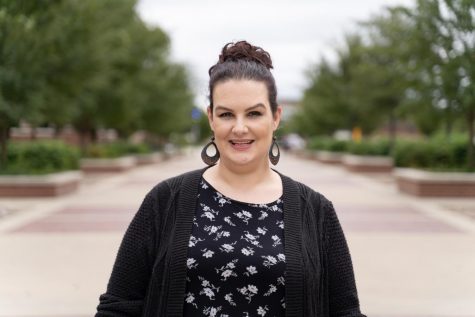
Audrey Korte was a reporter and the opinion editor for The Sunflower. She hosted The Sunflower News Podcast.
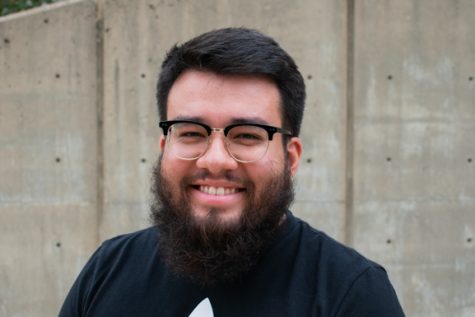
Eduardo Castillo was a former multimedia editor for The Sunflower. Castillo majored in communications.



